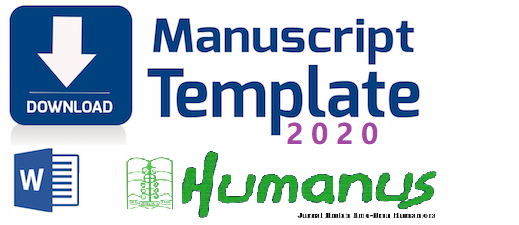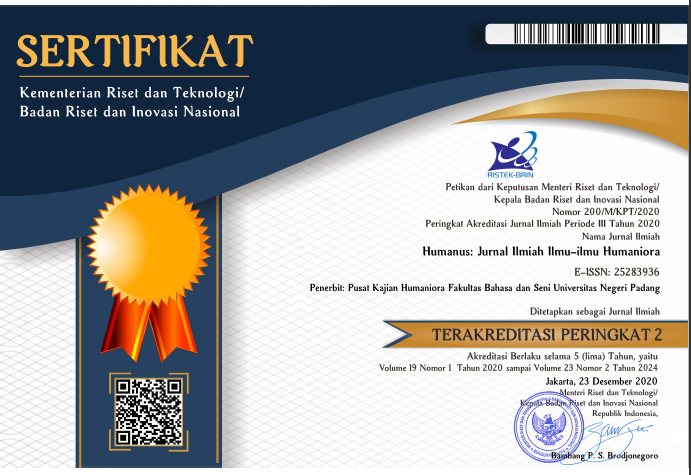Transitivity Analysis on Sri Mulyani’s Speech at Singapore Summit: A Systemic Functional Linguistics Perspective
 ), Nguyen Van Thao(5),
), Nguyen Van Thao(5), (1) STIT Al-Hilal Sigli, Aceh, Indonesia
(2) Universitas Diponegoro, Semarang
(3) Universitas Kristen Artha Wacana, Kupang
(4) Universitas HKBP Nommensen
(5) Hanoi Pedagogical University 2, Vinh Phuc, Vietnam
 Corresponding Author
Corresponding Author
Copyright (c) 2022 Humanus
DOI : https://doi.org/10.24036/humanus.v21i2.116665
Full Text:
 Language : en
Language : en
Abstract
This research discusses transitivity process in the speech of Sri Mulyani. This research aims to classify the type of transitivity process. This research employed systemic functional linguistics theory of Halliday, particularly transitivity system as a tool of analysis, more specific this research analyzed process of transitivity. The data collected from Sri Mulyani’ speech at Singapore Summit. The researchers used qualitative research design to answer the research question and chose content analysis because the result of the data analyzed is in descriptive phenomenon such as word, clause and utterance. The researchers used documentation as the research instrument. The researchers collected the data that is posted on September, 14th 2014. The findings of this research showed that material process was 44,29%, mental process was 24,29%, relational process was 25%, verbal process was 2,14%. behavioural process was 2,86% and existential process was 1,42%, so dominant process used on the speech was material process, the material process found 62 times with percentage 44,29 %. This research concluded that Sri Mulyani tended to use material process, in contrast with existential process which only have 1,42% as the lowest process in the speech. It showed that Sri Mulyani prefers to show the action and told what will they do for the next time.
Keywords
References
Ary, D., Jacobs, L. C., Sorensen, C., & Razavieh, A. (2010). Introduction to Research in Education. Wadsworth: Cengage Learning.
AYUNINGTYAS, I. P. (2020). Transitivity Analysis in John Franklin Stephen’S Speech “I Am a Man. See Me As a Human Being, Not a Birth Defect” Delivered in the United Nations, March 15, 2018 [UNIVERSITAS SANATA DHARMA YOGYAKARTA]. https://repository.usd.ac.id/37116/2/164214009_full.pdf
Halliday, M. A. K., & Matthiessen, C. (2014). An Introduction to Functional Grammar. Fourth Edition. London: Arnold Publication. https://www.functionalmedicine.org/files/library/Intro_Functional_Medicine.pdf
Herman. (2014). An Experiential Function on Students’ Genre of Writing. Jakarta: Halaman Moeka Publishing.
Herman, Murni, S. M., Sibarani, B., & Saragih, A. (2019). Structures of representational metafunctions of the “Cheng Beng” ceremony in pematangsiantar: A multimodal analysis. International Journal of Innovation, Creativity and Change, 8(4), 34–46. https://www.ijicc.net/images/vol8iss4/8403_Herman_2019_E_R.pdf
Herman, Van Thao, N., & Purba, N. A. (2021). Investigating sentence fragments in comic books: A syntactic perspective. World Journal of English Language, 11(2), 139–151. https://doi.org/10.5430/WJEL.V11N2P139
Hutabarat, E., Herman, H., Silalahi, D. E., & Sihombing, P. S. R. (2020). An Analysis of Ideational Metafunction on News Jakarta Post about Some Good Covid-19 Related News. VELES Voices of English Language Education Society, 4(2), 142–151. https://doi.org/10.29408/veles.v4i2.2526
Marbun, S., Silalahi, D. E., & Herman, H. (2021). Telling People to Change Their Behaviour Through Implications: An Implicature Analysis on Covid-19 Public Service Announcements in Indonesia. Elsya : Journal of English Language Studies, 3(3), 215–224. https://doi.org/10.31849/elsya.v3i3.6336
Ngongo, M. (2021). the Investigation of Modality and Adjunct in Spoken Text of Proposing a Girl Using Waijewa Language Based on Halliday’s Systemic Functional Linguistic Approach. ENGLISH REVIEW: Journal of English Education, 10(1), 223–234. https://doi.org/0.25134/erjee.v10i1.5382
Ngongo, M., & Ngongo, Y. (2022). Mood clauses in spoken text of proposing a girl using Waijewa language : A systemic functional linguistics approach. Journal of Language and Linguistic Studies, 18(1), 669–691.
Potradinata, S. L. A. (2018). An Analysis of Student’s Descriptive Text Writing in Systemic Functional Linguistic (SFL) Perspectives. International Journal of Languages, Literature and Linguistics, 4(2), 121–135. https://doi.org/10.18178/ijlll.2018.4.2.161
Purba, R., & Herman. (2020). Multimodal Analysis on Ertiga Car Advertisement. Wiralodra English Journal, 4(1), 21–32. https://doi.org/10.31943/wej.v4i1.77
Purba, R., HermanVeronika R. M. Manullang, & Ngongo, M. (2021). INVESTIGATION OF DECODING FILLERS USED IN AN ENGLISH LEARNING TALK SHOW “ ENGLISH WITH ALICE .” 10(1), 37–48.
Purba, R., Sibarani, B., Murni, S. M., Saragih, A., & Herman. (2022). Conserving the Simalungun Language Maintenance through Demographic Community: The Analysis of Taboo Words across Times. World Journal of English Language, 12(1), 40–49. https://doi.org/10.5430/WJEL.V12N1P40
Salsabil, S. (2014). A TRANSITIVITY ANALYSIS OF ENGLISH TEXTS IN BAHASA INGGRIS WHEN ENGLISH RINGS THE BELL. YOGYAKARTA STATE UNIVERSITY.
Sihombing, P. S. R., Silalahi, D. E., Saragih, D. I., & Herman, H. (2021). An Analysis of Illocutionary Act in Incredible 2 Movie. Budapest International Research and Critics Institute (BIRCI-Journal): Humanities and Social Sciences, 4(2), 1772–1783. https://doi.org/10.33258/birci.v4i2.1850
Sirait, M. F., Hutauruk, B. S., & Herman. (2020). The Effect of Using Speed Reading Technique to the Students’ Ability in Comprehending a Text. Cetta: Jurnal Ilmu Pendidikan, 3(3), 485–498. http://jayapanguspress.penerbit.org/index.php/cetta/article/view/545
Situmorang, R. K., & Herman. (2021). An Analysis of Slang Language Styles Used in Charlie’s Angels Movie. Journal of English Educational Study, 4(1), 21–29. https://doi.org/10.31932/jees.v4i1.820
Triana, M., Herman, H., Sinurat, B., & Silalahi, D. E. (2021). An Analysis of Students Perception on the Use of Google Classroom in English Language Learning. Cetta: Jurnal Ilmu Pendidikan, 4(3), 607–618. https://doi.org/10.37329/cetta.v4i3.1474
 Article Metrics
Article Metrics
 Abstract Views : 779 times
Abstract Views : 779 times
 PDF Downloaded : 207 times
PDF Downloaded : 207 times
Refbacks
- There are currently no refbacks.
Copyright (c) 2022 Humanus

This work is licensed under a Creative Commons Attribution-NonCommercial 4.0 International License.










